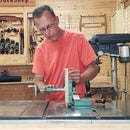Introduction: A Raised Panel Door Jig
This is a great jig for creating raised panels for cabinet doors, a simple to build jig for your table saw.
Step 1: Building the Face of the Jig
For the face of the jig I used 3/4 inch Oak that measures 15 inches in length by 12 inches tall..
I started building this jig by attaching a stop that runs across the 12 inch length of the face. Made from a piece of Walnut that measures 1 and 1/2 inches wide by 10 inches tall and a 1/4 of an inch in thickness. The stop was glued down and I used pin nails to hold it until the glue dried. Approximately 1 and a 1/2 inches in from one end.
Step 2:
Next I installed a toggle clamp by predrilling then attaching with screws.
Step 3: The Fence Guide
My idea was for the jig to ride the fence of my table saw while holding my material in place I wished to create the raised panel in as shown.
I wanted to use the fence as my guide for this jig mainly to create a quick set up time, but I also knew this would guarantee a square cut.
Step 4:
To achieve this I built a cradle made from 3/4 inch Oak and Walnut.
The Walnut would bridge the top of the fence connecting the face of the jig to the Oak runner on the opposite side of the fence.
Step 5:
With the pieces I was going to use cut to size I assembled the cradle using glue and screws.
I assembled this on my fence to ensure I would have a good tight fit, but loose enough the jig would still be able to slide the length of the fence with out binding.
Step 6:
The last thing I had to do was create a handle.
I shaped this from a piece of Oak then attached it using two dowel, one to the front and the other to the rear of the handle with glue.
Step 7: First Cut
To make my first cut with the jig I set my table saw blade at about a 18 degree angle and my fence distance from the blade was set so it would leave a 1/4 of an inch of material after I make my cut. With everything set up I made my first cut, then rotated my piece of stock clock wise to make my next repeating this until all four edges where cut.
Step 8:
The end result was a perfect raised panel for a door.
Step 9: Final Thoughts
My choice for materials for this project where not made for any reason other than this is what I had lying around in my scrap bin.
The finish I used on this jig was a wipe on polyurethane.
Over all I am very happy with the jig, it's really comfortable to use and it does a really nice job.
Step 10:
I always recommend watching the build video so that you have a better understanding of my building process.











